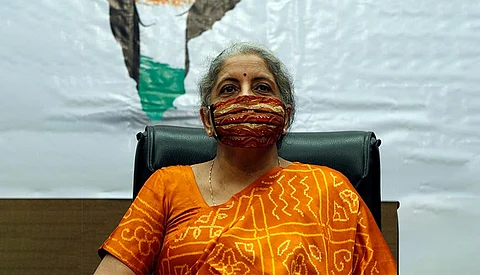
- Home
- About
- Globally Speaking
- Videos
- Podcast
- Geopolitics
- Industry
- SIGN UP

Fighting a war on two fronts, India has not only successfully managed the healthcare crisis but also scripted a strong economic revival setting a template for other nations to follow.
India’s finance minister Nirmala Sitharaman attended the first ever G20 Finance Ministers and Central Bank Governors (FMCBG) meeting under the Italian Presidency where she outlined how India has been able to contain the pandemic from a healthcare perspective while not letting it affect its economy in a catastrophic manner. It could not have happened on a better day.
READ MORE ON INDIAN ECONOMY:
Indian economy nears full recovery as Covid fears recede
How India’s maritime resurgence is helping harness blue economy
Universal tap water scheme a massive stimulus for the Indian economy
Modi’s fiscal prudence to help Indian economy bounce back this year
India may become worlds 3rd largest economy within next decade
Around the same time that Sitharaman was addressing the meeting virtually, India released its GDP estimates for the third quarter which showed a growth of 0.4 percent, which put the economy out of a technical recession.
During the meeting, she spoke about India’s policy response to the pandemic outlining how the domestic policies were broadly based on supporting citizens through measures such as credit guarantees, direct transfers, food guarantees, economic stimulus packages and accelerating structural reform. A country of over 1.3 billion people with a healthcare system that cannot be compared with any of the developed economies, India has the second largest number of cases after the US but is a distant third behind even Brazil in the number of fatalities. In terms of cases and deaths per million, it is one of the lowest around the world.
India’s policy response was based on two key fundamentals--an early lockdown to prevent the spread of the disease followed by a speedy and definitive unlockdown to expedite economic recovery. The fact that unlike other countries, it did not need a second or a third national lockdown is testimony to the success of the first strategy. It is something that has received praise from all quarters.
“India has shown great progress in significantly driving down the number of Covid19 cases. This shows us that if we can do these simple public health solutions, we can beat the virus,” said Tedros Adhanom, director general, World Health Organisation in January. “With vaccines being added we would even expect more and better outcomes.”
India is the largest producer of vaccines in the world and has also embarked on world’s largest and biggest vaccination drive, something that was touched upon by Sitharaman at the meeting as well. Not only that, India is also helping other countries by sending supplies by the millions at the same time.
All of this however, would not have meant as much if the ill effects of the pandemic on the country’s economy had not been expertly managed. The lockdown in March last year that extended until mid-May, did take a toll on India’s economy with the GDP crashing by an unprecedented 24.4 percent.
The gradual unlockdown saw the numbers improve in the second quarter but it was still in the red with a decline of 7.3 percent pushing the country to its first ever technical recession.
A robust revival in demand during the festive season that began in October coupled with strong resilience in the agricultural economy saw a better than expected performance in the third quarter. With the vaccination drive gathering momentum, things are only looking up. For the full fiscal year, the economy is still slated to contract by 8 percent but it is a far cry from a near 12 percent contraction that was projected by some rating agencies in the middle of last year.
“India’s policy response to COVID-19 was guided by the realisation that the GDP growth will come back, but not lost human lives. Early intense lockdown saved lives, helped faster recovery,” said KV Subramanian, India’s chief economic adviser while presenting the annual Economic Survey in January. “India undertook short term pain to get long term gain. The ‘V-shaped recovery’ makes India a sui generis case in mature policy making.”
There are still more upsides to the story. Most of the revival so far has been led by agriculture and manufacturing sectors. The services sector that contributes to a majority of the nation’s GDP has still been sluggish. The expectation is, as the vaccination drive covers more people, this sector would also grow giving fresh impetus to the revival story. At the same time however, the usual caveats remain valid. A second wave of infections can in one stroke, undo all the good work.
“The numbers are in line with the expectations and are reflective of the recovery being posted in most of the lead indicators. Even though recovery is broad based, the performance of the services sector - which constitutes a major part of our GDP- remains sluggish,” said Uday Shankar, president of industry body Federation of Indian Chambers of Commerce and Industry (FICCI). “We are happy to note that the worst is behind us but the fresh surge in COVID -19 cases being witnessed is a cause of worry. While the vaccination drive is progressing well in the country, it is extremely critical at this juncture to maintain caution and substantially speed up the immunization process.”
For many countries these worries are already a reality, in India they are only potential red flags. The fruits of the economic revival are more quantifiable and real. So is the success story of curbing the hydra headed virus. Even in the modern world of science, yet again it’s the world’s oldest civilization that has provided the answers.